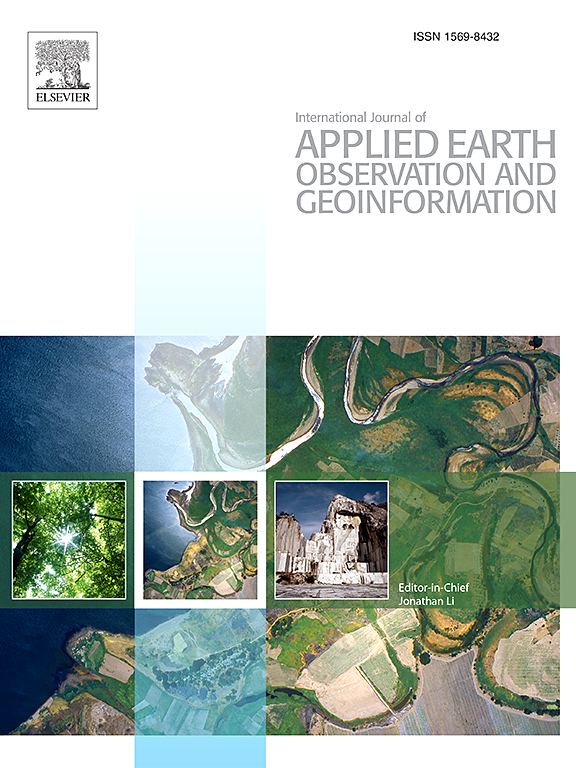评价水提取的光谱指数:限制和上下文使用建议
IF 7.6
Q1 REMOTE SENSING
International journal of applied earth observation and geoinformation : ITC journal
Pub Date : 2025-03-29
DOI:10.1016/j.jag.2025.104510
引用次数: 0
摘要
随着气候变化和人类活动的加剧,水资源短缺、洪水和水质异常日益严重。通过对水体空间分布和动态的精细监测,确保水资源管理、洪水监测和水质评价的有效实现是当务之急。目前,各种技术已经应用于水信息监测,其中基于遥感的光谱指数方法由于其简单、低成本和大规模观测能力而得到广泛应用。然而,现有的水谱指数种类繁多,每一个都适用于不同的场景和目标,这使得普通用户很难选择最合适的指数并确定其最佳用途(即阈值设置)。本研究利用全球14个代表性地区的Sentinel-2图像,通过评估15种广泛使用的水探测指数的性能和适用性,解决了这些挑战。结果表明,不同情景下水资源指数的表现存在差异。常见的问题包括在高反射率背景(如建筑物和雪)、低反射率背景(如阴影)中的错误识别,以及对叶绿素含量高的水体的遗漏错误。在此基础上,给出了不同情景下水体指数选择推荐表和指标阈值推荐范围表,并指出了水体指数未来发展的重点方向。该研究为实际应用中水体指标的选择和使用提供了有价值的指导,有助于提高水体精细尺度监测的准确性和效率。本文章由计算机程序翻译,如有差异,请以英文原文为准。
Evaluating spectral indices for water extraction: Limitations and contextual usage recommendations
With the intensification of climate change and human activities, water resource shortages, floods, and water quality anomalies are becoming increasingly serious. It is urgent to ensure the effective realization of water resource management, flood monitoring, and water quality assessment through fine-scale monitoring of water body spatial distribution and dynamics. Currently, various technologies have been applied to water information monitoring, with remote sensing-based spectral index methods being widely used due to their simplicity, low cost, and large-scale observation capabilities. However, the wide variety of existing water spectral indices, each suited to different scenarios and objectives, makes it challenging for ordinary users to select the most appropriate index and determine its optimal usage (i.e., threshold settings). This study addresses these challenges by evaluating the performance and applicability of 15 widely used water detection indices, using Sentinel-2 imagery across 14 representative global regions. The results revealed that the performance of water indices varied across different scenarios. Common issues include misidentification in high-reflectance backgrounds (e.g., buildings and snow), low-reflectance backgrounds (e.g., shadows), and omission errors for water bodies with high chlorophyll content. On this basis, this study provides a recommended table for water body index selection in different scenarios and a recommended range table for index thresholds, and point out key directions for future development of water body indices. This study offers valuable guidance for the selection and use of water body indices in practical application, helping to enhance the accuracy and efficiency of fine-scale monitoring of water bodies.
求助全文
通过发布文献求助,成功后即可免费获取论文全文。
去求助
来源期刊

International journal of applied earth observation and geoinformation : ITC journal
Global and Planetary Change, Management, Monitoring, Policy and Law, Earth-Surface Processes, Computers in Earth Sciences
CiteScore
12.00
自引率
0.00%
发文量
0
审稿时长
77 days
期刊介绍:
The International Journal of Applied Earth Observation and Geoinformation publishes original papers that utilize earth observation data for natural resource and environmental inventory and management. These data primarily originate from remote sensing platforms, including satellites and aircraft, supplemented by surface and subsurface measurements. Addressing natural resources such as forests, agricultural land, soils, and water, as well as environmental concerns like biodiversity, land degradation, and hazards, the journal explores conceptual and data-driven approaches. It covers geoinformation themes like capturing, databasing, visualization, interpretation, data quality, and spatial uncertainty.
 求助内容:
求助内容: 应助结果提醒方式:
应助结果提醒方式:


